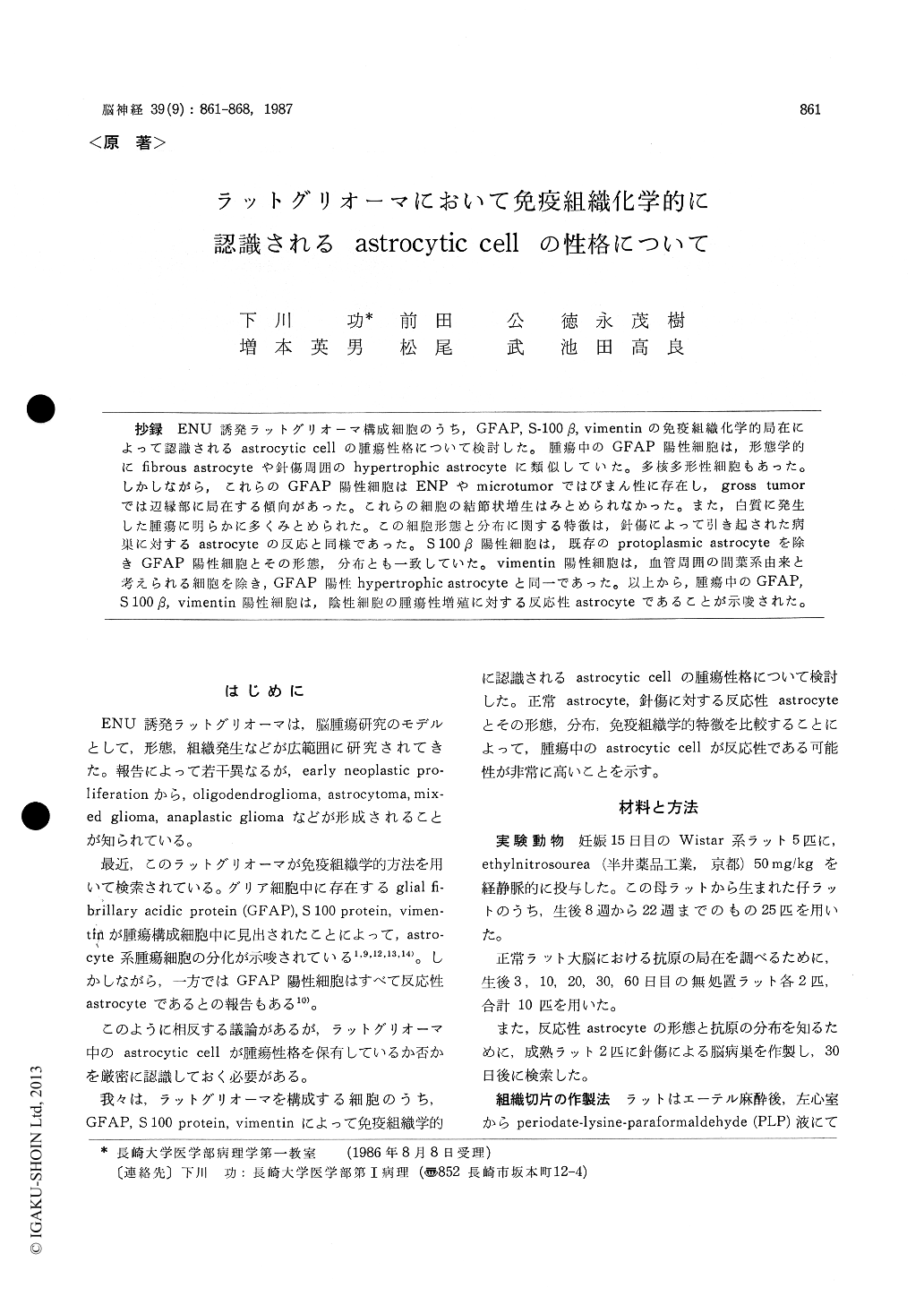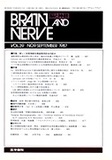Japanese
English
- 有料閲覧
- Abstract 文献概要
- 1ページ目 Look Inside
抄録 ENU誘発ラットグリオーマ構成細胞のうち,GFAP,S−100β,vimentinの免疫組織化学的局在によって認識されるastrocytic cellの腫瘍性格について検討した。腫瘍中のGFAP陽性細胞は,形態学的にfibrous astrocyteや針傷周囲のhypertrophic astrocyteに類似していた。多核多形性細胞もあった。しかしながら,これらのGFAP陽性細胞はENPやmicrotumorではびまん性に存在し,gross tumorでは辺縁部に局在する傾向があった。これらの細胞の結節状増生はみとめられなかった。また,白質に発生した腫瘍に明らかに多くみとめられた。この細胞形態と分布に関する特徴は,針傷によって引き起された病巣に対するastrocyteの反応と同様であった。S100β陽性細胞は,既存のprotoplasmic astrocyteを除きGFAP陽性細胞とその形態,分布とも一致していた。vimentin陽性細胞は,血管周囲の間葉系由来と考えられる細胞を除き,GFAP陽性hypertrophic astrocyteと同一であった。以上から,腫瘍中のGFAP,S100β,vimentin陽性細胞は,陰性細胞の腫瘍性増殖に対する反応性astrocyteであることが示唆された。
The nature of astrocytic cells in rat gliomas induced by ethylnitrosourea (ENU) was studied by means of immunohistochemically demonstrating glial fibrillary acidic protein (GFAP), vimentin and β-subunit of S 100 protein (S 100 β) on para-ffin sections. A special attention was paid to elucidating whether astrocytic cells would be neo-plastic or not. The astrocytic cells in tumors were compared with astrocytes in normal rat brains and reactive astrocytes around a stab wound for their morphology, distribution and immuno-histochemical characteristics.
GFAP positive astrocytic cells in tumors were roughly divided into astrocytic cells and hyper-trophic cells that showed morphologically similar appearances to fibrous astrocytes and hypertro-phic reactive astrocytes around a stab wound re-spectively. A few multi-nucleated pleomorphic cells regarded as a kind of hypertrophic cells were also noted in gross tumors. GFAP positive cells were diffusely distributed in early neoplastic proliferations and microtumors, while in gross tumors they tended to be localized at the peri-phery. The GFAP positive cells were scattered among negative cells of tumors, forming no tumor mass. These findings suggest that the GFAP positive cells show no neoplastic growth, even though histopathologically they exhibit a-typism or pleomorphism.
The quantitative analysis of GFAP positive cells in tumors indicated more than 8% in most tumors in the white matter, whereas less than 8% in tumors in the gray matter and approxi-mately 5% in gross tumors. The predominance of GFAP positive cells in the white matter was also observed in lesions induced by a stab wound Actually, the morphological and distributional analogies between GFAP positive cells in tumors and positive cells around a stab wound suggest that the positive cells in tumors might be reactive cells associated with tissue destruction by tumor growth.
Isomorphic proliferations of astrocytic cells were found exclusively in the gray matter, although they showed no destructive growth. They are considered to be reactive lesions induced by re-trograde degeneration of axons, but their exact nature remains uncertain.
S 100 /9 positive cells in tumors were almost the same as GFAP positive cells on their mor-phology and distribution, except for pre-existed protoplasmic astrocytes.
Vimentin, that was detected in a few immature glias in neonatal brains but not in fibrous astro-cytes, was found in hypertrophic astrocytes both in tumors and around a stab wound. GFAP negative oligodendrocytes like cells and anaplastic glias in tumors were also negative for vimentin. The detection of vimentin in hypertrophic as-trocytes may represent an increase of the filament in reactive cells.
Elliptic cells arranged concentrically around blood vessels were positive for vimentin. The existence of reticulin fibers among these cells and the association of these cells with blood vessels suggest their mesenchymal origin and resemblance to gliosarcomatous proliferation in human.
Finally, immunohistochemically defined astro-cytic cells in tumors are suggested to be reactive cells. As neoplastic cells proliferate, numerous reactive astrocytes in the white matter may in-termingle to form so-called mixed gliomas, while those in the gray matter being few may form oligodendrogliomas. In addition, the appearance of atypism or pleomorphism in reactive astrocytes and neoplastic cells may lead to a diagnosis of anaplastic gliomas. The nature of neoplastic cells of rat gliomas remains uncertain for the present but other markers may identify a certain astro-cytic nature in neoplastic cells.

Copyright © 1987, Igaku-Shoin Ltd. All rights reserved.


